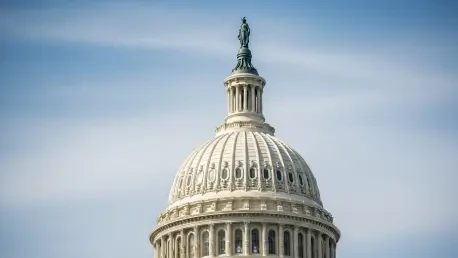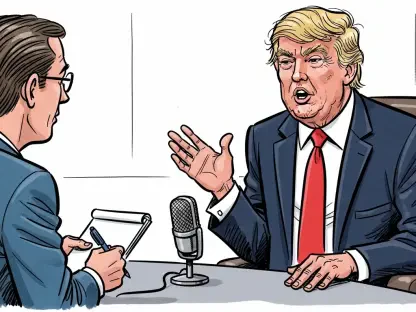As the current government shutdown stretches into a record-threatening duration, surpassing 36 days, the impact on federal workers, public services, and national morale grows increasingly severe, painting a grim picture of the crisis. Imagine hundreds of thousands of employees furloughed, national parks shuttered, and critical programs stalled, all while lawmakers grapple with finding a resolution to this historic impasse. This roundup dives into the heart of bipartisan negotiations, gathering perspectives from key congressional figures and legislative insiders to assess whether a breakthrough is on the horizon. The purpose is to synthesize diverse opinions on the ongoing talks, highlight emerging solutions, and provide clarity on what might finally end this unprecedented deadlock.
Bipartisan Negotiations: A Spectrum of Perspectives
Senate Talks: Signs of Slow Progress
Insights from Senate discussions reveal a cautious but tangible shift toward dialogue. Several senators involved in the negotiations note that conversations have become more constructive over recent weeks, focusing on finding common ground. While no one claims a deal is imminent, the tone suggests a willingness to keep pushing forward despite entrenched differences.
A significant point of contention remains the alignment of party priorities, with some lawmakers emphasizing the need to protect essential services while others prioritize fiscal restraint. This balancing act has slowed progress, yet the mere continuation of talks is seen as a positive step by many observers. The Senate’s role as a potential mediator in this crisis is becoming clearer as discussions evolve.
Comparisons to past shutdowns highlight that such incremental movement often precedes a resolution, though the complexity of current issues adds a layer of uncertainty. Insiders stress that patience is critical at this stage, as premature optimism could derail delicate negotiations. The focus remains on maintaining open channels of communication to avoid further escalation.
Legislative Frameworks: What’s on the Table?
Turning to specific proposals, a framework combining full-year appropriations for select agencies like Veterans Affairs and Agriculture with a temporary funding extension for others is gaining traction. Legislative aides suggest this hybrid approach could address immediate needs while buying time for broader budget agreements. The idea is to prevent a complete standstill in government operations.
However, there’s debate over the timeline of a new continuing resolution, with some advocating for a deadline beyond the outdated November 21 mark to allow more breathing room. Senate leaders have hinted at the risks of relying on stopgap measures for too long, as they could delay comprehensive fiscal planning into the next year. This concern weighs heavily on strategists crafting the proposals.
Differing views emerge on whether this piecemeal strategy will satisfy all parties or simply kick the can down the road. While some see it as a pragmatic compromise, others warn that without addressing core disagreements, any solution remains temporary at best. The challenge lies in ensuring these measures don’t become a crutch for avoiding tougher decisions.
Senate and House: A Tale of Two Chambers
The political landscape between the Senate and House presents a stark contrast, with the Senate leaning toward bipartisan compromise and the House pushing aggressive budget cuts for fiscal plans spanning from now to 2027. Analysts point out that this divide shapes the negotiation process, often stalling momentum as each chamber digs into its respective stance. Bridging this gap is a central hurdle.
Some congressional staffers argue that the Senate’s current collaborative spirit could eventually influence House strategies if key leaders step in to mediate. Yet, others caution that the House’s firm position on reductions might dominate if no concessions are made. This dynamic creates a tense backdrop to the ongoing talks, with resolution hinging on cross-chamber coordination.
The disparity also fuels speculation about whether deeper gridlock awaits if the two bodies cannot reconcile their approaches. Observers note that public frustration over disrupted services might force a reckoning, pushing lawmakers to prioritize unity over ideology. How this tension plays out in the coming days remains a critical question for all stakeholders.
Lawmaker Sentiments: Optimism or Reservation?
Diving into individual perspectives, a spectrum of cautious hope emerges among senators involved in the talks. Certain lawmakers express subtle confidence that the Senate is moving closer to an endpoint, emphasizing recent productive sessions as evidence of progress. Their outlook, while guarded, hints at a belief in eventual success.
In contrast, other key figures adopt a more reserved stance, pointing to the outcomes of recent party caucus meetings as still inconclusive. They underscore that while dialogue continues, significant barriers persist, making any prediction of a swift resolution premature. This tempered view serves as a reminder of the stakes involved.
Historical comparisons provide context, with some veterans of past shutdowns suggesting that the current atmosphere mirrors moments just before breakthroughs in prior crises. Yet, public pressure and the mounting toll on government functionality add a unique urgency this time around. These mixed sentiments reflect the delicate balance lawmakers must strike.
Key Takeaways from the Shutdown Saga
Synthesizing the range of opinions, it’s evident that Senate negotiations have made incremental strides, with a potential legislative package taking shape that balances immediate funding needs with temporary extensions. The focus on full-year appropriations for critical agencies signals a targeted effort to stabilize key sectors. However, unresolved disputes and the looming House-Senate divide keep a full resolution out of reach for now.
Another recurring theme is the recognition that outdated deadlines for continuing resolutions must be revised to reflect the current reality of negotiations. Lawmakers across the board agree that flexibility in timing could prevent further disruptions. This consensus offers a sliver of hope amid broader disagreements over long-term fiscal strategy.
For those tracking this crisis, staying informed through updates from congressional leaders and monitoring legislative calendars is essential. Keeping an eye on public statements from both chambers can provide early indicators of shifts in strategy. Engaging with reliable news sources also helps cut through the noise of speculation surrounding the talks.
Reflecting on a Historic Impasse
Looking back, the journey through this prolonged government shutdown revealed deep-seated divisions but also glimmers of bipartisan resolve. The slow grind of Senate talks, contrasted with the House’s unyielding stance, painted a complex picture of governance under pressure. Lawmakers’ varied sentiments underscored both the challenges and the potential for compromise that defined this period.
Moving forward, actionable steps include urging representatives to prioritize essential services in any deal, ensuring that federal workers and public programs no longer bear the brunt of political stalemate. Advocacy for transparent communication from Congress can also help maintain trust during such crises. As the situation unfolds, exploring historical case studies of shutdown resolutions might offer valuable lessons for preventing similar standoffs down the line.









